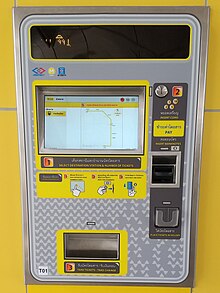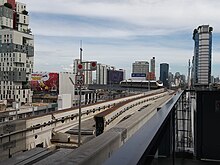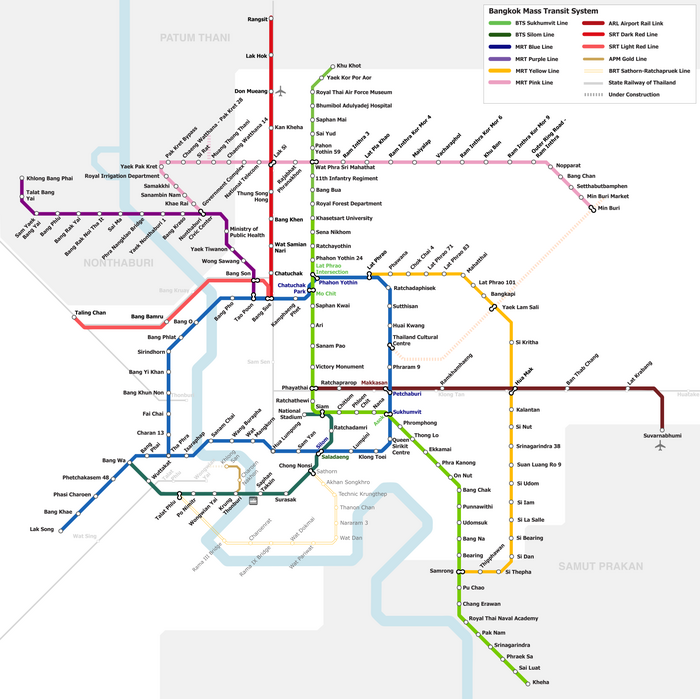The MRT Yellow Line (Thai: รถไฟฟ้ามหานคร สายสีเหลือง) or MRT Nakkhara Phiphat Line (Thai: รถไฟฟ้ามหานคร สายนัคราพิพัฒน์) is an elevated monorail line in Bangkok and Samut Prakan Province, Thailand, part of the MRT rapid transit system. The 30.4 km (18.9 mi) line has 23 stations and cost 55 billion baht.[4] The line was originally proposed in 2005 by the Office of Transport and Traffic Policy and Planning to be a heavy rail underground line along Lat Phrao road which was then elevated from Lam Sali Intersection to Samrong. However, it was decided in 2012 to build an elevated monorail line for the whole length in order to reduce construction costs.
MRT Yellow Line or Nakkhara Phiphat Line สายนัคราพิพัฒน์ | |
|---|---|
 | |
 A Bombardier Innovia Monorail 300 at Bang Kapi station | |
| Overview | |
| Owner | Mass Rapid Transit Authority of Thailand |
| Locale | Bangkok and Samut Prakan, Thailand |
| Termini | |
| Stations | 23 |
| Website | https://mrta-yellowline.com |
| Service | |
| Type | Monorail |
| System | Metropolitan Rapid Transit |
| Operator(s) | Eastern Bangkok Monorail Company Limited (Subsidiary of BSR Consortium) |
| Depot(s) | Si Iam |
| Rolling stock | Bombardier Innovia Monorail 300 4 cars per trainset |
| Daily ridership | 72,807[1] |
| History | |
| Opened | 3 July 2023 |
| Technical | |
| Line length | 30.4 kilometers (18.9 mi) (est.)[2] |
| Number of tracks | 2 monorail tracks |
| Character | Elevated |
| Electrification | 750 V DC |
| Operating speed | 80 km/h (50 mph) |
| Signalling | Bombardier CITYFLO 650 moving block CBTC ATC under ATO GoA 4 (Fully Automated Train Control), with subsystems of ATP, ATS and CBI[3] |





The Yellow Line provides mass transit along the heavily congested Lat Phrao Road and Srinagarindra Road corridors. The line links 6 other lines; the MRT Blue Line, interchange with the MRT Orange Line (which is under construction), the planned MRT Grey Line and MRT Brown Line, the Airport Rail Link (Bangkok) and finally the BTS Sukhumvit Line. As such, it is an important cross city link in the middle north-eastern and eastern areas of Bangkok.
Preliminary site works began in late 2017 with major construction work starting from March 2018. In October 2020, the BSR stated that they plan to open the first section of the Yellow Line by October 2021 with initial operations running from Samrong to Si Iam.[5] The line was then planned to fully open in July 2022.[6] However, due to COVID-19 outbreaks in Bangkok delaying construction with sites closed, the BSR stated that the first section of the line would not open until July 2022.[7] On 29 November 2021, daily testing began on a 6 km (3.7 mi) section of the line between the depot at Si Iam and Srinagarindra 38 station. Testing was expanded after a 3-month period.[7]
In mid-April 2022, the Director of EBM/BSR, Mr Surapong Laoha-Unya, stated that further labour & installation delays would mean that the line would now not open until September 2022.[8] Construction had progressed to 99.02% as of the end of April 2023.[9]
After repeated delays, the line partially opened to the public for free trial rides on 3 June 2023 from Hua Mak to Samrong,[10] having done a private trial ride between Kalantan and Samrong for the press the day before. Trial rides for Phawana to Hua Mak section began on 12 June,[11] while the final section between Phawana and Lat Phrao station opened on 19 June.[12][13]
Rabbit Card or EMV credit cards are accepted on the MRT Yellow Line, although pricing is yet to be determined.[13]
Route alignment
The line starts at the intersection of Ratchadaphisek and Lat Phrao roads where it interchanges with the MRT Blue Line at Lat Phrao station. The line then heads east along Lat Phrao road to Bang Kapi intersection and south to Lam Sali station to interchange with the MRT Orange Line and the future MRT Brown Line. The line continues further south along Srinagarindra Road to Hua Mak where it interchanges with the Airport Rail Link at Hua Mak station.
From Hua Mak, the route continues south along Srinagarindra Road past the Debaratna (Bang Na-Trat) Road all the way to Thepharak Road in Samut Prakan Province, then heading west along Thepharak Road where it terminates at Samrong and interchanges with Samrong of the BTS Sukhumvit Line.[14]
The line stretches from Lat Phrao (YL1) to Samrong (YL23) and the depot is located at Debaratana Road adjacent to Si Iam station (YL17).
History

The Yellow line was first proposed in the mid 1990s as a monorail line by Japanese consultants with little or no progress for 10 years. In 2004, the Office of Transport and Traffic Policy and Planning (OTP) reworked the proposal as a heavy rail line with underground and elevated sections as part of the 10 line metro plan which was taken to the February 2005 election. In 2009, it was suggested to change the line to an elevated monorail line as a cost saving measure. In December 2011, the MRTA was instructed by the MOT to divide the Yellow Line into two phases for tender and construction purposes and to reduce land appropriation costs.[15] In June 2012, the MRTA contracted consultants to undertake detailed designs of the line. In February 2013, OTP stated that the tender for the Yellow Line should be ready by late 2013 for tender in early 2014.[16] By August 2013, this timeline had changed to a mid 2014 tender date.[17]
However, similar to the MRT Pink Line, delays in finalising the technical requirements of the tender in relation to the selection of monorail rolling stock which determines the type of track to be constructed resulted in further delays. The subsequent political turmoil of late 2013 and early 2014 caused even more delays. Thereafter, a coup in May 2014 resulted in a new military administration and the tender being deferred while a review of all mass transit projects was undertaken for a period of 18 months. The MRTA was instructed by the junta government to change to a PPP tender process which was subsequently not released until mid-2016. In early December 2016, The BSR consortium consisting of BTS Group Holdings (75% majority stake) with Sino-Thai Engineering and Construction (STEC), and Ratchaburi Electricity Generation Holding (RATCH), won the bid construct and operate the Yellow Line. The BSR also won the bid to build and operate the MRT Pink Line.[18]
On June 16, 2017, the contract was signed for the project between the Mass Rapid Transit Authority of Thailand and BSR consortium. The BSR established the Eastern Bangkok Monorail Company Limited (EBM) to operate the line. A proposed 2 station extension of the route north from the Lat Phrao terminus to link to the BTS Sukhumvit Line at Ratchayothin station has also been proposed by the BSR Joint Venture.[19] However, this extension is opposed by the MRT Blue Line operator BEM due to concerns regarding loss of revenue.[20]
Construction of the Yellow Line began in March 2018.[21]
The public trial run started on 3 June 2023, between Hua Mak and Samrong. The Phawana-Si Kritha section opened on 12 June,[11] while Lat Phrao station opened on 19 June.[12][13]
As of June, 2024. Passengers are required to change train due to technical difficulties, sections of station runs in different frequency. Latphrao to Huamak runs every 5 minutes, Huamak to Sri Iam runs every 25 minutes and from Sri Iam to the terminus Samrong every 10 minutes. Yellow maintainace carts can been seen along the line from Huamak to Samrong.
Rolling stock
- Innovia Monorail 300 rolling stock used on the Yellow line, at Si Kritha station
- Innovia Monorail 300 trains at Lat Phrao Station
- Interior of the Yellow Line train
- Interior of the Yellow Line train
- Yellow Line train departing Thipphawan station towards Samrong station
BSR selected Bombardier Innovia Monorail 300 rolling stock for the Yellow line.[22] The BSR announced that they would purchase 28 4-car sets to operate the Yellow line.[23] The trains were manufactured by CRRC Puzhen Bombardier Transportation Systems (joint venture of Bombardier Transportation and CRRC Nanjing Puzhen) in Wuhu, Anhui, China. The first set was assembled and shipped on 4 September 2020 with delivery to Thailand at the end of September 2020.[24] The first set arrived in Thailand on 1 October 2020 at Laem Chabang port with a handover ceremony attended by the Thai Prime Minister, BTSC Chairman, MRTA and Canadian Ambassador.[25] Two more sets arrived in mid December 2020 for a total of 5 sets by the end of 2020. By July 2021, 8 sets had been delivered and were being tested.[26] As of the end of October 2021, 12 sets had been delivered.[27] By the end of November 2021, the BSR stated that 20 sets had been delivered with the remaining sets expected to be fully delivered by the end of March 2022.[7] However, as of mid April 2022 only 26 sets had been received and were progressing undergoing testing.[28] The remaining sets were expected to be delivered by July 2022.
Technical Characteristics
- Low profile vehicles/low floor height above beam[29]
- Distinct sloped nose/end-cap
- Inter-car walkthrough[29]
- Rubber-tires and permanent magnet motor[29]
- Aluminium body, steel underframe, composite end cap
- 4-car sets have a capacity of 24,100 pax p/h each way and 8-car sets a capacity of 49.600 pax p/h each way with a 75-second headway.[30]
- Innovia Monorails are all fully automated and are equipped with CITYFLO 650 GOA 4 (Fully Automated Train Control)communications-based train control for driverless operation to increase reliability, shorten head ways between trains and lower maintenance costs.[31]
The BSR stated that the passenger capacity for 4-car sets will be 17,000 passengers per hour each way.
Guidebeams

The Bombardier Innovia Monorail 300 operates on a narrow, elevated guidebeam. Pre-cast, post-tensioned guidebeams are constructed at an off-site location and later installed on the system. The guidebeams are 690 mm (27 in) wide.[29] The Innovia Monorail 300 was designed to navigate curves as tight as 46 m (151 ft) and a maximum grade of 6%. Monorail switches are either beam replacement or multi-position pivot switches.[32] The system has evacuation walkways down the entire length of the guidebeam. These walkways allow passengers to escape any onboard hazard. The maintenance crew also uses these walkways for repairs and general maintenance to the system.[33]
List of stations

| Code | Station Name | Transfers | Opened | Province | |
|---|---|---|---|---|---|
| English | Thai | ||||
| YL 01 | Lat Phrao | ลาดพร้าว | MRT Lat Phrao | 19 June 2023[12][13] | Bangkok |
| YL 02 | Phawana | ภาวนา | 12 June 2023[11] | ||
| YL 03 | Chok Chai 4 | โชคชัย 4 | |||
| YL 04 | Lat Phrao 71 | ลาดพร้าว 71 | |||
| YL 05 | Lat Phrao 83 | ลาดพร้าว 83 | MRL Chalong Rat (proposed) | ||
| YL 06 | Mahat Thai | มหาดไทย | |||
| YL 07 | Lat Phrao 101 | ลาดพร้าว 101 | |||
| YL 08 | Bang Kapi | บางกะปิ | |||
| YL 09 | Yaek Lam Sali | แยกลำสาลี | MRT Yaek Lam Sali (under construction) MRT Chalong Rat (design phase) | ||
| YL 10 | Si Kritha | ศรีกรีฑา | |||
| YL 11 | Hua Mak | หัวหมาก | SRT Hua Mak (tender in 2023)  ARL Hua Mak ARL Hua Mak | 3 June 2023[34] | |
| YL 12 | Kalantan | กลันตัน | |||
| YL 13 | Si Nut | ศรีนุช | |||
| YL 14 | Srinagarindra 38 | ศรีนครินทร์ 38 | |||
| YL 15 | Suan Luang Rama IX | สวนหลวง ร.9 | |||
| YL 16 | Si Udom | ศรีอุดม | |||
| YL 17 | Si Iam | ศรีเอี่ยม | BTS (planned) | ||
| YL 18 | Si La Salle | ศรีลาซาล | |||
| YL 19 | Si Bearing | ศรีแบริ่ง | Samut Prakan | ||
| YL 20 | Si Dan | ศรีด่าน | |||
| YL 21 | Si Thepha | ศรีเทพา | |||
| YL 22 | Thipphawan | ทิพวัล | |||
| YL 23 | Samrong | สำโรง | BTS Samrong | ||
The 30.4 km Yellow Line has 23 stations.[35]
Potential future extension
A proposed 2 station extension of the route north from the current Ratchada terminus to link to the BTS Sukhumvit Line Extension at Ratchayothin station has also been proposed by the BSR Joint Venture.[19] However, this extension is opposed by the MRT Blue Line operator BEM,[20] estimating about 988 million baht loss on the extension's first year of service and 2.7 billion baht throughout the 30-year concession period.[36]
The extension was approved in February 2021, with construction set to be completed in 2024.[37] However, EBM has repeatedly denied MRTA's request to provide a compensation for BEM, which may result in a cancellation of the extension if no decision has been made.[36][38]
The Yellow Line terminates at Samrong. A future extension from Samrong across the Chao Phraya River to link with the MRT Purple Line at Rat Burana was canvassed by the OTP in the early 2010s. However, the location and design of Samrong station excludes any further extension of the line west of Sukhumvit Road.
| Code | Station Name | Transfers | Province | |
|---|---|---|---|---|
| English | Thai | |||
| YLEX 02 | Phahonyothin 24 (proposed extension) | พหลโยธิน 24 | BTS Phahonyothin 24 | Bangkok |
| YLEX 01 | Chankasem (proposed extension) | จันทรเกษม | Bangkok | |
| YL 01 | Lat Phrao | ลาดพร้าว | MRT Lat Phrao | Bangkok |
Network map
Incidents
January 2024 Equipment Failure
On 2 January 2024, a guide wheel from one of the trains fell off between Si Thepha Station and Si Dan Station and hit a taxi on Thepharak Road. There were no injuries.[39] Investigations found the cause due to a broken ball bearing socket holding the wheels. The event followed a similar incident a week earlier on the Pink Line, where a 300-meter section of the on conductor rail fell onto the road near Samakkhi station.[40] The following day, trains operated at 55-minute intervals with many complaints from commuters returning to work on the first day after the new year holidays.[41] EBM is expected to be fined heavily for the damage. Service was restored on 4 January with trains running at 15-minute intervals free of charge.[42]
March 2024 Equipment Failures
On 28 March 2024 loose bolts caused parts fell from the conductor rail to the street below between Kalantan and Si Udom stations causing service to be suspended and damaging vehicles.[43] The following day limited service was resumed[44] but a power outage at Hua Mak caused a further partial suspension of service.[45] Six stations were still closed two days after the incident.[46] Repairs to the affected section could take 2-3 months.[47]
See also
- Mass Rapid Transit Master Plan in Bangkok Metropolitan Region
- MRT (Bangkok)
- MRT Blue Line
- MRT Brown Line
- MRT Grey Line
- MRT Light Blue Line
- MRT Orange Line
- MRT Purple Line
- MRT Pink Line
- BTS Skytrain
- BTS Sukhumvit Line
- BTS Silom Line
- Airport Rail Link (Bangkok)
- SRT Light Red Line
- SRT Dark Red Line
- Bangkok BRT
- BMA Gold Line
References
External links





